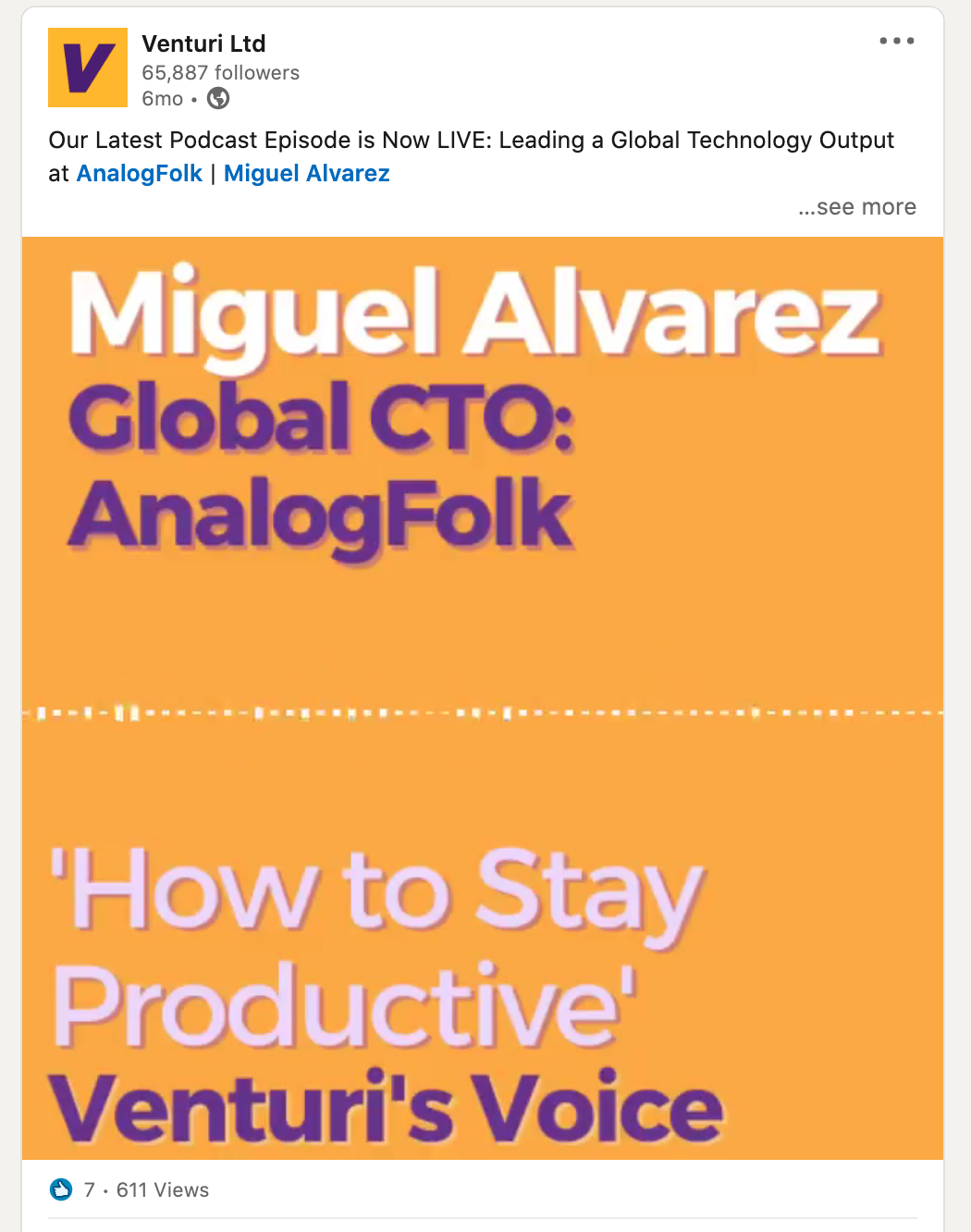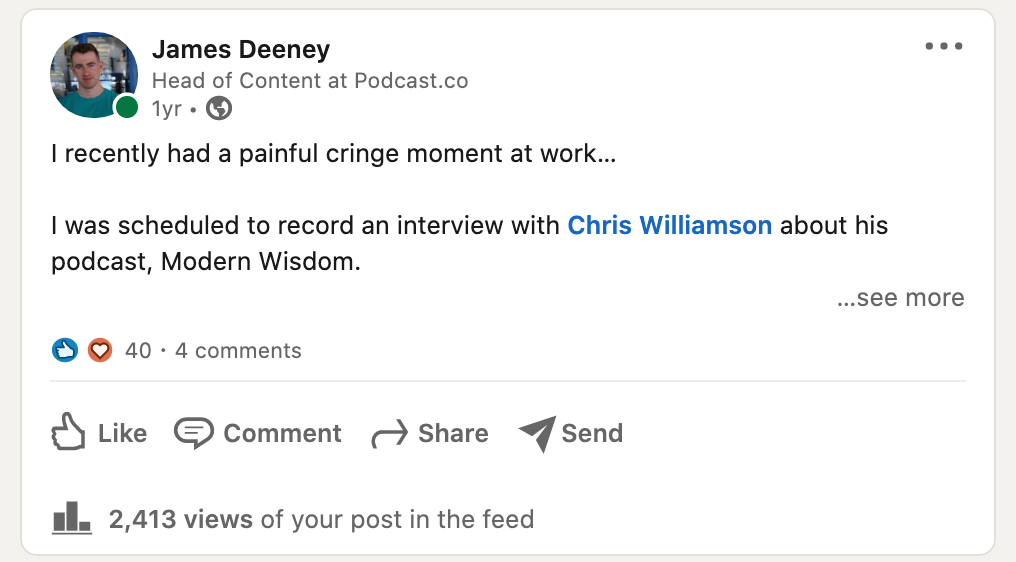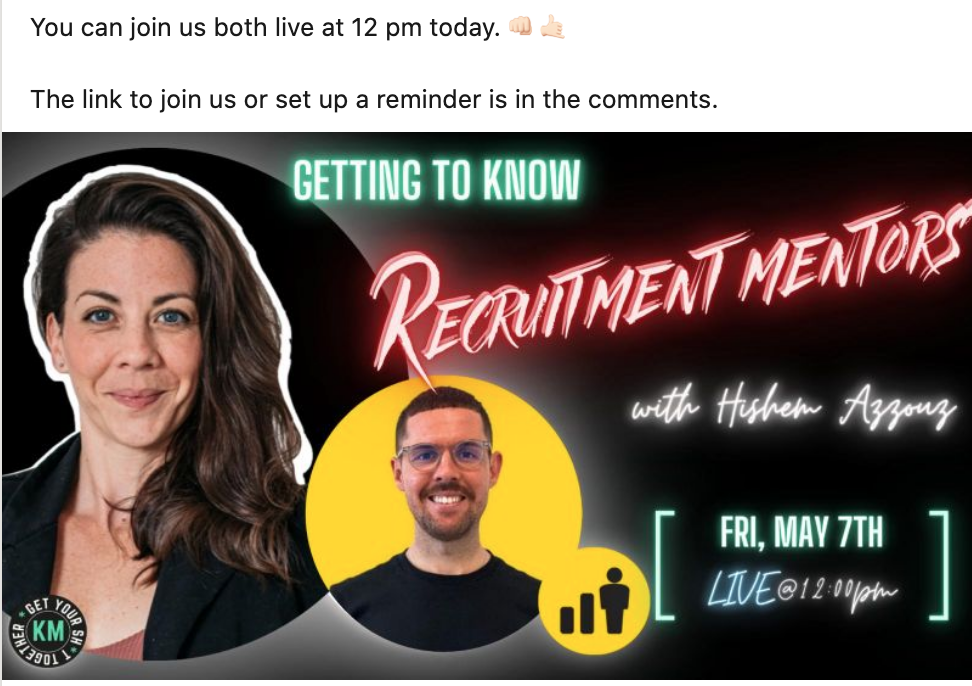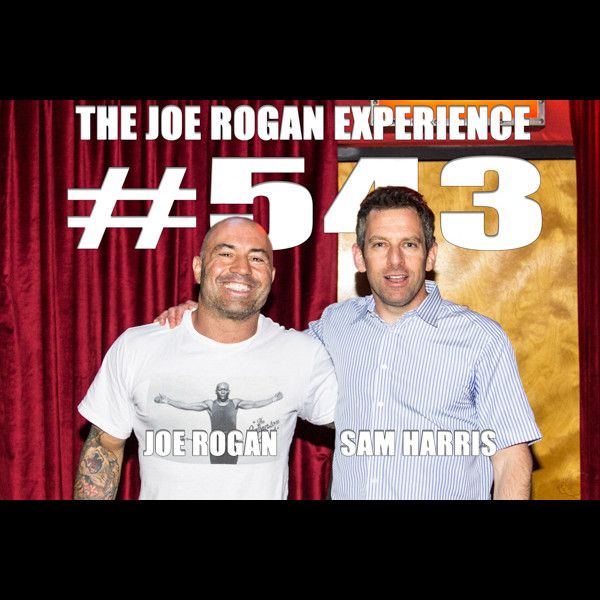If you’re running a podcast to market your business, chances are you’re already using LinkedIn to promote your new episodes (and if you aren’t, now’s a good time to start).
But on a platform inundated with professional and B2B content, it can be hard to get traction. Many posts get buried as soon as they’re published. They fail to get likes and comments. As a result, the algorithm doesn’t pick them up. And in the end, they do very little to help either your podcast or your business. Sound familiar?
It’s common for business podcasters to waste hours each week creating LinkedIn posts that deliver no return. Yet most keep going under the assumption that “doing something is better than doing nothing”. But if you’re getting a clear signal that what you’re doing isn’t working, it’s time to reconsider your approach.
So why is it that most podcast promo posts on LinkedIn fail? The answer is simple:
LinkedIn posts that are purely promotional in nature offer nothing to the reader. People don’t really care much about your podcast (sorry, the truth hurts). So simply announcing a new episode has been published isn’t going to get engagement. Your post itself needs to do the hard work of sparking reaction, intrigue, and interest in the minds of readers.
In this article we’ll outline how you can use the power of storytelling to craft compelling LinkedIn posts that don’t fall flat.
Getting the LinkedIn Basics Right
Before we get into writing posts, it’s important to nail down the LinkedIn fundamentals first. Run through the checklist below to make sure your profile is optimized to grow both your show and your business.
Your header image
- Have you replaced the default profile header image with a custom one?
- Is it a good reflection of your personal brand?
- Does it suggest you’re a podcast host?
Your profile headline
- Avoid simply listing your current job title or experience
- Does it speak to the audience you want to attract?
- Does it suggest how you can help your audience?
- It should make people think “I need what they deliver!”
Your about section
- Does it reference your podcast?
- Does it include a list of relevant keywords associated with your podcast topic?
- Have you used all of the 2,000 characters you’re allowed?
Your experience section
- Have you added your role as a podcast host to your experience section?
- Tell people about your show, what you talk about, and why they should listen.
- Do you also appear on other podcasts as a guest? If so, let people know.
Your profile media
- Choose some of your best / most popular episodes and add them as media.
- If you’ve created a podcast trailer, add that to your profile media too.
Your podcast page
- Have you created a dedicated “company” page for your podcast?
- Does it showcase your podcast’s brand and purpose?
- Do you post to your podcast page as well as your personal one?
- Check out Jordan Harbinger’s podcast page for inspiration and guidance.
Getting the elements above right isn’t difficult. So it’s a good starting point. But these profile updates and changes will effectively be meaningless if all your posts are purely promotional. For more on getting the basics right on LinkedIn, check out the video below from MatchMaker.fm and Podcast.co founder, James Mulvany:

Book your next guest the easy way
With more than 40,000 members, MatchMaker.fm is the largest online community connecting podcasters & guests.
Join MatchMaker todayIt's free to join!
What is a “Purely Promotional” Podcast Post?
So what are we referring to by “purely promotional”? To better understand what not to do, let’s dissect the post below:

Most podcast posts on LinkedIn tend to look something like this. It lets people know the episode is live, the guest is tagged, and a highlight snippet from the episode has been converted into an audiogram (for more on creating audiograms, check out this guide).
It’s branded and professional. It’s inoffensive. It’s intended to be helpful. But it’s blander than dry toast. It simply can’t compete with other more engaging and provocative posts in a news feed. Readers don’t have any real incentive to click “see more” or go listen to the full episode (unless they happen to be weirdly fanatical about workplace productivity). Now we’ve cleared up what to avoid, let’s get into the anatomy of a great LinkedIn post.
Storytelling Is King on LinkedIn
Rather than announcing that your new episode has just gone live, tell people a story about it instead. Give them a reason to care.
If you pay attention to your LinkedIn newsfeed, you’ll notice posts that get lots of engagement usually tell some kind of story. Often these posts take the form of a thinly-veiled humble brag. So much so that this format has become an insider joke in the LinkedIn community thanks to the existence of “influencer” accounts such as the one run by Oleg Vishnepolsky, CTO of the DailyMail.

You may not have aspirations to become the next Oleg. But you can definitely learn something here. There’s a reason he continues to pump out these posts at the rate he does. Because they actually work. And while its easy to poke fun at the content of some LinkedIn humble brags, there is a skill and craft associated with creating them. If it was really easy to do the world would have a lot more Olegs.
These storytelling posts hook you in with a strong opening line and inctice you to click “see more” to find out what happens next. By the time you get to the end they’ve either entertained, surprised, or informed you. The post itself has added value to you in some way, and that makes it worth liking, sharing, or commenting on.
There may be a link to another website, video, or podcast within the post itself or in the comments section (more on that later). But the post offers more than that. It’s a unique and engaging piece of short-form content in its own right. And that’s something you should keep in mind when creating your own posts.
When it comes to telling a story about your latest podcast episode, you’ve got multiple options:
- Did your guest recount a good story or anecdote during the interview? If so, use the details as the basis of your post. If you aren’t already, get into the habit of getting your guests to tell you stories during interviews.
- Did any funny or interesting interactions happen between you and your guest before, during, or after the interview?
- Is there a particular reason you invited this particular guest on your show? Do you look up to and respect them? Has their work had a significant impact on the world or your life? Whatever the reason, you can let people know in your post.
- Is there a topic you touched on in the interview that is particularly compelling or controversial? If so, could you use that as the basis of your post?
For example, last year I recorded a series of interviews for my show, Meet the Podcasters. After one of the first recordings, I made a rookie technical error and accidentally deleted the audio file. So we had to re-do the interview. It was painfully embarrassing. But this is exactly the kind of thing that can form the basis of a story to promote the episode (of course, I would never recommend intentionally deleting recordings for the purpose of a LinkedIn post).

So once you’ve decided on the angle you want to take with your post, how do you go about crafting it?
Maximising Your “See More” Click Rate
Dave Harland is a genuine master of the LinkedIn storytelling format. Copywriter by trade, he’s built an impressive following with his often informative and always hilarious posts. If you want to get more engagement on your own posts you should follow his page and study his work. You’ll learn a lot by trying to identify the elements that make his posts so successful.
The one thing all Dave’s posts have in common is a fantastic opening. Every single one of them compels you to click the “see more” button.

And then comes the big reveal…

Getting this right is difficult, but it’s arguably the most important step in the process. If people skim by your post without reading the full thing, all the time you spent lovingly crafting your story will have been wasted.
With that in mind, give your post’s opening lines special attention. This is where the real creative work comes in. You’re very unlikely to nail it on your first attempt. It’s going to take multiple edits and iterations to eventually land on something you genuinely think will work. When you feel confident in what you’ve came up with, put yourself in the mindframe of someone who knows nothing about you or your podcast and ask yourself the question:
If I saw these opening lines on my news feed, would I click “see more”?
If they answer is yes then run with it. You won’t always get it right of course. But through a process of trial and error, you’ll begin to build an intuitive sense of what will work and what won’t.
It’s still important the rest of your post is engaging and well-written. But you don’t need to take as much care as you do with the opening line. Once you’ve convinced a reader to click “see more”, the real battle is already over. They’re invested and chances are they’re going to read till the end.
To learn more about the art of crafting brilliant LinkedIn posts, check out the webinar below from none other than Dave Harland himself (I guarantee it’ll be the most useful content you consume today, this article aside, obviously).
Teasing Episode Content
The whole point of all this is you encourage people to go listen to the full episode. So alongside the story you tell, it’s important to let readers know what they can expect to learn by clicking the link and giving you more of their time and attention. There’s no reason to overcomlicate this. A couple of sentences detailing the most interesting topics covered in your episode is enough.
For inspiration, check out the descriptior for this episode of Conversations with Coleman featuring Michael Shermer, founding publisher of Skeptic Magazine:
Michael and I talked about the declining relevance of Christianity on the political landscape today, threats to free speech, QAnon, conspiracy theories, and why people believe them. We talked about the one conspiracy theory I do believe in and laws that would ban the teaching of Critical Race Theory in schools, and much more.
If any of the topics listed in your post caputre the interest of readers, they’ll likely follow through to the full episode. Not everyone who engages with your post will do this. But a certain percentage always will. So the more traction you get via the LinkedIn algorithm, the more listeners and downloads you’ll get.
Where to Place Your Episode Link
The issue of where to place the link to your episode in your LinkedIn posts is hotly debated. Some feel it’s fine to include the link within the post itself. Others argue that you should always drop the link to the episode in the comment section.

The reason this debate exists in the first place is due to how the LinkedIn algorithm works. As a company, LinkedIn want to maximise the amount of time people spend on their platform, because that translates into greater profits and revenue. So it doesn’t make sense for them to recommend and promote posts that direct users away from the platform to 3rd party sites (such as your podcast homepage).
For that reason, some people feel putting the link in the comments is a way to get around being penalised by the algorithm in this way. But the jury is still out on this. There are plenty of examples of posts including 3rd party links which get lots of engagement. The workings of the LinkedIn algorithm are commercially sensitive, so nobody knows how it actually works. We’d recommend doing you own experimentation to see what works for you. There is no black and white answer here unfortunately.
Adding Hashtags
When it comes to hastags on your story post, less is more. Two or three carefully selected hashtags is more than enough. It’ll boost the chances of your post picking up additional traction.
Don’t stuff the final segment of your post with 10+ hashtags. It’s not a “hack” that works. If it did, you wouldn’t be reading this article. Plus it looks a bit desperate and cheapens the effort you’ve invested in creating a great post. Don’t be that person.
Adding Images & Audiograms
To add an image or not to add an image? That is the question.
Again, there’s no clear cut answer here. An image of your guest or audiogram highlight from the interview can certainly make your post more visually engaging. On that note, if you happen to record interviews in person, it’s always worth taking an episode promo photo with each guest. If you don’t use it on LinkedIn, it’ll certainly come in handy on your Instagram page.

Photos and audiograms stand out more in news feeds. And in some cases they may help compensate for a less than perfect opening line. But if your copywriting is good enough, images and audiograms aren’t essential. Feel free to experiment and figure out what seems to resonate most with your network.
Justifying the Time Investment
Obviously this is a much more demanding and involved process than posting “NEW EPISODE OUT NOW!”
But what’s the point of shouting about your latest episodes on LinkedIn if nobody is paying any attention? You actually have to put in some time and effort into your posts if you want them to get engagement. There are no shortcuts or hacks here.
But there is only so much time in a week. Especially when you’re trying to run a business alongside your podcast. So you may not have time to create a captivating LinkedIn story for every single episode you publish. And that’s fine. You don’t need to.
But for those episodes you’re particularly proud of, it’s worth doing a extra bit of legwork to try and reach a wider audience. You’ll learn lots of valuable lessons through the process of trial and error. So don’t be disheartened if some of your LinkedIn stories don’t quite land like you thought they would. Not every post will be a winner. The important thing is making a commitment to put the effort into this element of your podcast promotion strategy.

Book your next guest the easy way
With more than 40,000 members, MatchMaker.fm is the largest online community connecting podcasters & guests.
Join MatchMaker todayIt's free to join!






